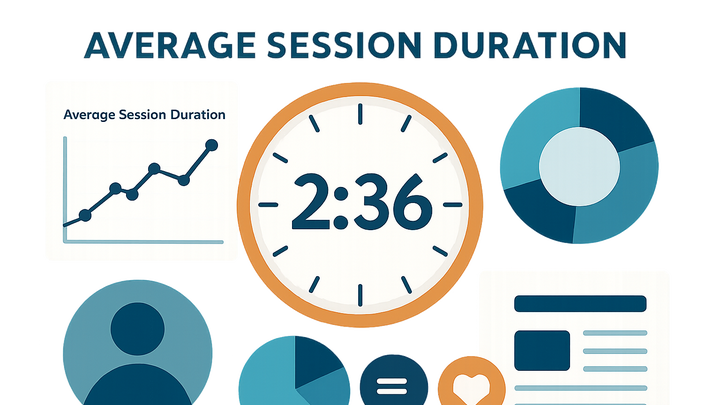Published on 2025-06-28T06:11:05Z
What is Average Session Duration? Examples and Best Practices
Average Session Duration is a key metric in web analytics that represents the mean time users spend on your website during a single session. A session begins when a user arrives on any page of your site and ends after 30 minutes of inactivity or at midnight. This metric helps you understand overall engagement by indicating how long visitors interact with your content. Different analytics platforms like GA4 and PlainSignal may calculate session duration slightly differently, so it’s important to know the specifics of each tool. Average Session Duration can be influenced by factors such as page load speed, content quality, and navigation structure. Monitoring trends over time and across traffic sources enables you to assess the effectiveness of site updates and marketing campaigns.
Average session duration
The mean time users spend on your website per session, reflecting overall engagement levels.
Understanding Average Session Duration
Average Session Duration measures the average length of time that users actively engage with your website in a single session. It is calculated by dividing the total duration of all sessions by the number of sessions in a given period. Sessions start with the first user interaction (pageview or event) and end after a predefined inactivity timeout (typically 30 minutes) or at midnight. This metric provides a high-level view of user engagement but should be interpreted alongside related metrics for a fuller picture.
-
Definition
Average Session Duration equals the Total Duration of All Sessions divided by the Number of Sessions over a specified timeframe.
-
Session boundaries
A session begins at the first hit (pageview/event) and ends after 30 minutes of inactivity or when the campaign source changes or the clock strikes midnight.
Why Average Session Duration Matters
Average Session Duration offers insights into how users interact with your site and consume your content. Longer sessions generally indicate that visitors find your material valuable and are exploring multiple pages. Short sessions may signal that content is not resonating or that technical issues are driving users away. Tracking this metric over time and across different segments (such as traffic sources) helps identify strengths and areas for improvement in your digital strategy.
-
Engagement signal
Higher average durations often correlate with more engaging content and a better user experience.
-
Ux feedback
A sudden drop in average session duration after a redesign can indicate navigation or usability problems.
-
Marketing insights
Comparing session durations by channel helps pinpoint which campaigns drive the most engaged visitors.
How Average Session Duration is Calculated
Different analytics platforms use timestamp differences between user interactions to compute session duration. Understanding each tool’s methodology is crucial to avoid misinterpretation and ensure consistent reporting.
-
GA4 calculation method
GA4 calculates session duration by summing the difference between the first and last event timestamps for each session, then dividing by total sessions. Sessions with only one event are recorded as zero seconds.
-
Common pitfalls
Bounce sessions (single-hit sessions) can skew the average toward zero. Missing or misconfigured events may underreport session length.
Implementing Tracking: GA4 and PlainSignal Examples
Include the following snippets in the <head> of your HTML pages to enable session tracking in GA4 and PlainSignal. Proper placement ensures accurate measurement of pageviews and events used to calculate session durations.
-
GA4 tracking example
Standard GA4 snippet that initializes pageview tracking for session duration measurement.
-
Code snippet
<script async src="https://www.googletagmanager.com/gtag/js?id=G-XXXXXXX"></script> <script> window.dataLayer = window.dataLayer || []; function gtag(){dataLayer.push(arguments);} gtag('js', new Date()); gtag('config', 'G-XXXXXXX'); </script>
-
-
PlainSignal tracking example
Cookie-free PlainSignal snippet for simple session tracking without relying on user-level cookies.
-
Code snippet
<link rel="preconnect" href="//eu.plainsignal.com/" crossorigin /> <script defer data-do="yourwebsitedomain.com" data-id="0GQV1xmtzQQ" data-api="//eu.plainsignal.com" src="//cdn.plainsignal.com/plainsignal-min.js"></script>
-
Best Practices to Improve Average Session Duration
Optimizing session duration involves enhancing content quality, user experience, and site performance. Implement strategies that encourage deeper engagement and longer visits.
-
Content structuring
Use clear headings, bullet points, and multimedia to break up text and maintain reader interest.
-
Internal linking
Guide users to related articles or pages with contextual links to prolong their journey on your site.
-
Page speed optimization
Reduce load times through image optimization, caching, and minification to prevent session drops caused by slow performance.
-
Interactive elements
Incorporate quizzes, polls, or comments to invite user participation and extend session lengths.
